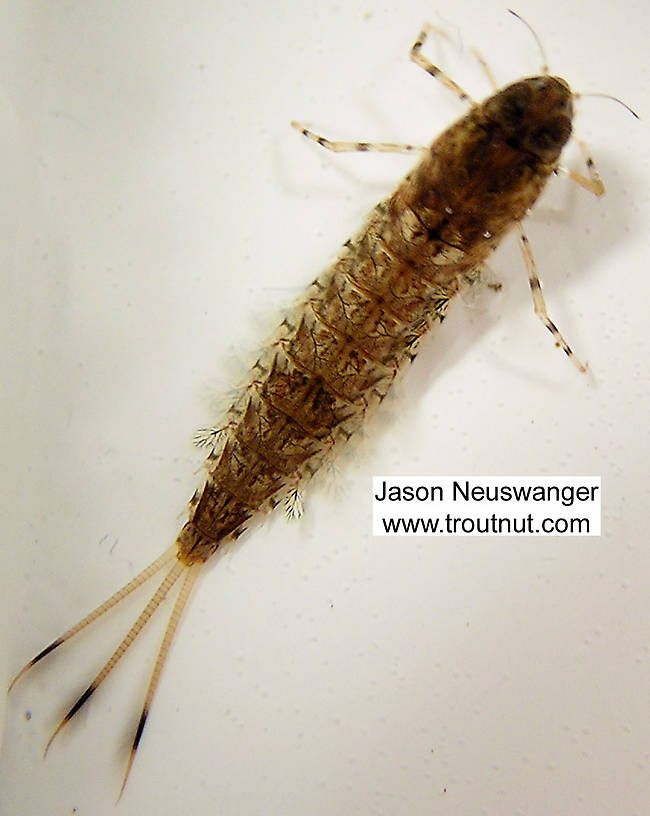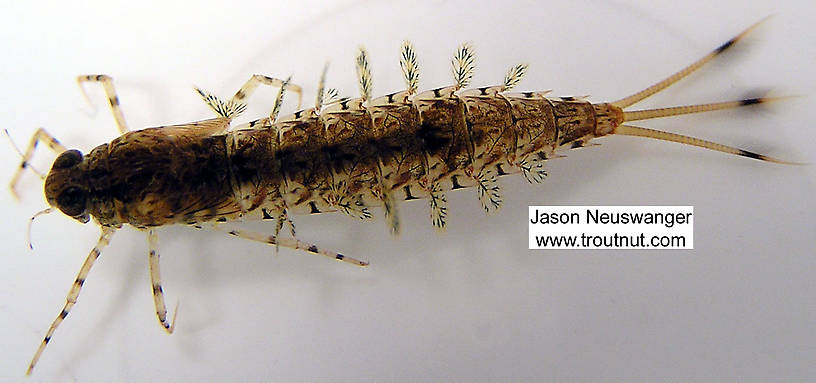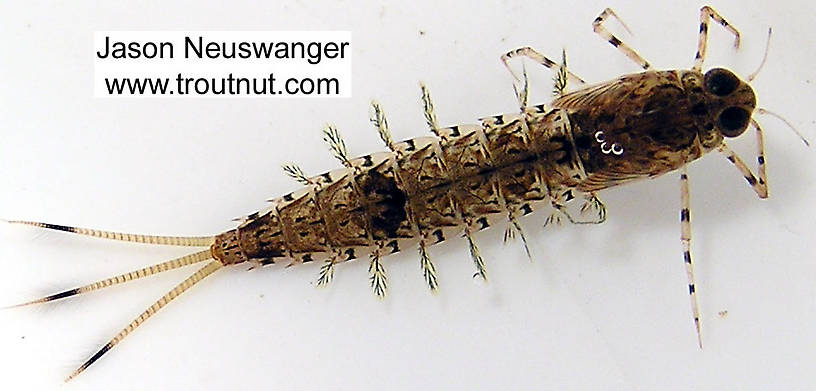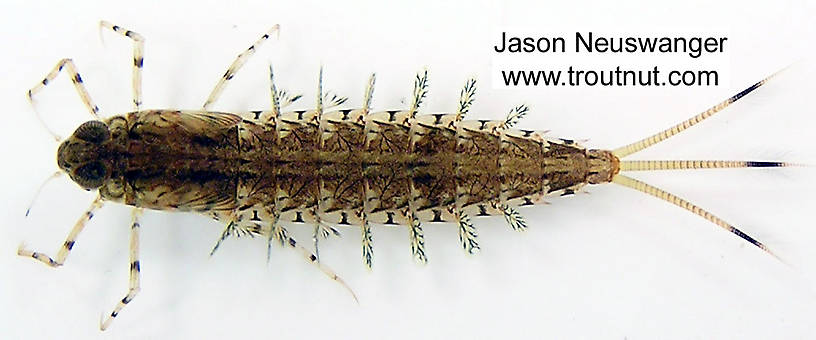
Hex Mayflies
Hexagenia limbata
The famous nocturnal Hex hatch of the Midwest (and a few other lucky locations) stirs to the surface mythically large brown trout that only touch streamers for the rest of the year.
Featured on the forum

Troutnut is a project started in 2003 by salmonid ecologist Jason "Troutnut" Neuswanger to help anglers and
fly tyers unabashedly embrace the entomological side of the sport. Learn more about Troutnut or
support the project for an enhanced experience here.
Identification: Key to Families of Mayfly Nymphs, Couplet 14
Identification: Key to Families of Mayfly Nymphs, Couplet 14
Error: Tried to access a key that isn't live.
Adapted from Merritt R.W., Cummins, K.W., and Berg, M.B. (2019)
This couplet refers figures (usually designated 'sf') from this source.
You will need the source (make sure to get the same edition!) to see them.
This couplet refers figures (usually designated 'sf') from this source.
You will need the source (make sure to get the same edition!) to see them.
| Option 1 | Option 2 |
|---|---|
| Tarsal claws of forelegs simple, with long slender denticles (source fig 13.26a) | Tarsal claws of forelegs bifid, giving the appearance of two claws 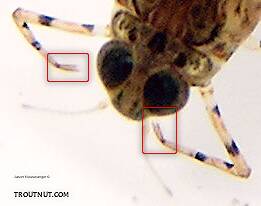
|
| Spinous pad present on forecoxae | No spinous pad on forecoxae |
5 Example Specimens | |
| Ametropodidae Genus Ametropus | Metretopodidae |
Adapted from Merritt R.W., Cummins, K.W., and Berg, M.B. (2019)
The current couplet is highlighted with darker colors and a icon, and couplets leading to this point have a icon.
Leads to Baetiscidae
(Baetisca):
(Baetisca):
- Mesonotum enlarged to form a shield extended to abdominal segment VI (in other words, they look like they're wearing a turtle shell)
- Abdominal gills enclosed beneath shield
Leads to Couplet 2:
- Mesonotum not enlarged as above
- At least some abdominal gills exposed
Couplet 2
Leads to Couplet 3:
- Gills on abdominal segments 2-7 forked, long, and pointy, with margins fringed creating a "feathery" appearance
- Usually with mandibular tusks projected forward and visible from above head Or, if tusks absent, head and thorax with pads of long spines (source fig 13.8)
Couplet 3
Leads to Couplet 7:
- Gills on segments 2-7 variable; if gills are forked, long, and pointy, then their margins not fringed (source fig 13.6)
- Mandibular tusks very rarely present
Couplet 7
Leads to Behningiidae
(Dolania americana):
(Dolania americana):
- Head and prothorax with dorsal pads of long spines (source fig 13.9)
- Mandibular tusks absent
- Abdominal gills ventral
Behningiidae
(Dolania americana)
(Dolania americana)
Leads to Couplet 4:
- Head and prothorax without pads of long spines
- Mandibular tusks present
- Abdominal gills lateral or dorsal
Couplet 4
Leads to Couplet 6:
- Foretibiae not adapted for burrowing (source fig 13.8)
- Abdominal gills lateral
Couplet 6
Leads to Couplet 5:
- Foretibiae modified for burrowing, either broad or with tubercles (source fig 13.7)
- Abdominal gills dorsal
Couplet 5
Leads to Euthyplociidae
(Euthyplocia hecuba):
(Euthyplocia hecuba):
- Mandibular tusks with many long setae (source fig 13.4)
Euthyplociidae
(Euthyplocia hecuba)
(Euthyplocia hecuba)
Leads to Potamanthidae
(Anthopotamus):
(Anthopotamus):
- Mandibular tusks without many long setae (source fig 13.8)
Leads to Couplet 19:
- Tips of mandibular tusks curved upward when viewed laterally (source fig 13.10)
- Ventral apex of hind tibiae developed as a distinct acute point (source fig 13.12)
Couplet 19
Leads to Polymitarcyidae:
- Tips of mandibular tusks not curved upward when viewed laterally (source fig 13.10)
- Ventral apex of hind tibiae rounded (source fig 13.13)
Leads to Couplet 20:
- Two rows of long hair-like setae present on inner margins of tibiae and femora of forelegs
Couplet 20
Leads to Couplet 8:
- Long hair-like setae absent from forelegs, or not arranged as above
Couplet 8
Leads to Couplet 9:
- Gills on abdominal segment II operculate or semioperculate
Couplet 9
Leads to Couplet 11:
- Gills on adbominal segment II neither operculate nor semioperculate, either similar to those on succeeding segments or absent
Couplet 11
Leads to Leptohyphidae:
- Gills on abdominal segment 2 triangular, subtriangular, or oval and not meeting medially (source fig 13.15)
- Gill lamellae on segments 3-6 simple or bilobed, without fringed margins
Leads to Couplet 10:
- Gills on abdominal segment 2 quadrate, meeting or almost meeting medially (source fig 13.16a)
- Gill lamellae on segments 3-6 with fringed margins (source fig 13.16b)
Couplet 10
Leads to Caenidae:
- Mesonotum without anterolateral lobes (source fig 13.18)
- Operculate gills on abdominal segment 2 not fused medially
- Hind wing pads absent
Leads to Neoephemeridae
(Neoephemera):
(Neoephemera):
- Mesonotum with distinct rounded lobe on anterolateral corners (source fig 13.17)
- Operculate gills on abdominal segment 2 fused medially
- Hind wing pads present
Leads to Ephemerellidae:
- Gills absent on abdominal segment 2, rudimentary or absent on segment 1, and present or absent on segment 3 (source figs 13.19, 13.44); abdominal gills when present on segments 3-7 or 4-7 consist of oval anterior / dorsal lamellae and posterior / ventral lamellae with numerous lobes
- Paired tubercles or spines often present on abdominal terga, ranging in size from very prominent to subtle, but absent in some common species
Leads to Couplet 12:
- Gills present on abdominal segments 1-5, 1-7, or 2-7
- Abdominal terga usually lacking paired tubercles
Couplet 12
Leads to Couplet 21:
- Head and body distinctly flattened, with eyes and antennae on dorsal surface, and mandibles not visible from dorsal view
Couplet 21
Leads to Couplet 13:
- Body either not flattened (source figs 13.33, 13.24), or flattened but with mandibles visible dorsally and forming an integral part of the flattened head surface (source fig 13.25)
Couplet 13
Leads to Couplet 14:
- Tarsal claws of forelegs differ in structure from those on middle and hind legs (source figs 13.26, 13.27)
- Tarsal claws of middle and hind legs long and slender, about as long as tibiae
Couplet 14
Leads to Couplet 15:
- Tarsal claws of all legs similar, usually sharply pointed, but can also be spatulate
- Tarsal claws variable in length; if tarsal claws of middle and hind legs long and slender, then tarsal claws usually shorter than tibiae; if middle and hind tarsal claws longer than respective tibiae, then legs wither bowed or labrum with a deep v-shaped notch
Couplet 15
Couplet 14 (You are here)
Leads to Ametropodidae
(Ametropus):
(Ametropus):
- Tarsal claws of forelegs simple, with long slender denticles (source fig 13.26a)
- Spinous pad present on forecoxae
Leads to Metretopodidae:
- Tarsal claws of forelegs bifid, giving the appearance of two claws
- No spinous pad on forecoxae
Leads to Leptophlebiidae:
- Gills on abdominal segments 2-7 either forked , in tufts (source fig 13.28), have all margins fringed (source fig 13.29), or have double lamellae that terminate with a single filament at multiple points
- Apicolateral margin of maxillae with dense brush of long setae (source fig 13.33)
Leads to Couplet 16:
- Abdominal gills not as described; gills either approximately oval or heart-shaped; gill lamellae either single-, double-, or triple-folded (source figs 13.35-13.38); gill lamellae with posterior surface membrane just covering individual tracheal branches in one rare genus (source fig 13.39); abdominal gills never terminate as a sharp filament or with multiple points
- Apical margin of maxillae variable, but never with dense brush of long setae (source figs 13.34, 13.43)
Couplet 16
Leads to Baetidae:
- Labrum with median notch on anterior margin (except in uncommon genus Apobaetis, which lacks well-developed posterolateral projections on abdominal segments 6-9)
- Maxillae without pectinate spines
- Middle tail variable, ranging from the same as the outer tails to a barely-visible stub less than the length of tergite 10
- Antennae length variable
Leads to Couplet 17:
- Labrum without median notch on anterior margin
- Maxillae have pectinate spines if antennae longer than twice the width of the head
- Middle tail length approximately equal to outer tails
- Either antennae shorter than twice the width of the head (source fig 13.41) or labrum with notched anterior margin and maxillae with pectinate spines (source fig 13.43)
Couplet 17
Leads to Acanthametropodidae:
- Tibiae and tarsi bowed
- Tarsal claws very long and slender, with those on hind legs about as long as hind tarsi (source fig 13.26)
- Rare and found in large rivers
Acanthametropodidae
Leads to Couplet 18:
- Tibiae and tarsi not bowed
- Tarsal claws usually not long and slender
Couplet 18
Leads to Ameletidae
(Ameletus):
(Ameletus):
- Maxillae with crown of pectinate spines
- Abdominal gills roughly oval single lamellae, with a distinct sclerotized band along lateral margin and usually with a similar sclerotized band on or near the mesal margin
Leads to Siphlonuridae:
- Maxillae without pectinate spines
- Abdominal gills variable, but without such sclerotized bands or edges, and often with two lamellae per segment; usually much more restricted and weakly sclerotized, appearing nearly transparent
Leads to Palingeniidae:
- Mandibular tusks with a distinct lateral keel that is more or less toothed and with some multi-point spurs (source fig 13.101)
Leads to Ephemeridae:
- Mandibular tusks without a toothed lateral keel (source fig 13.10)
Leads to Isonychiidae
(Isonychia):
(Isonychia):
- Gills on abdominal segment 1 dorsolateral, similar in position and structure to gills on segments 2-7
- Gill fibrils shorter than gill lamellae
Leads to Oligoneuriidae:
- Gills on abdominal segment 1 ventral, whereas gills on segments 2-7 dorsal (source fig 13.14)
- Gill fibrils longer than gill lamellae, or gill lamellae absent
Oligoneuriidae
Leads to Pseudironidae
(Pseudiron centralis):
(Pseudiron centralis):
- Tarsal claws as long as or longer than tarsi
- Tibiae and tarsi bowed
- Rare
- Found in large, sandy rivers
Leads to Couplet 22:
- Tarsal claws much shorter than tarsi
- Tibiae and tarsi straight
- Common
Couplet 22
Leads to Arthropleidae
(Arthroplea bipunctata):
(Arthroplea bipunctata):
- Segment 2 of maxillary palpi longer than width of head and usually held conspicuously at or behind the side of the head (source fig 13.61)
- Uncommon and found at the edges of stream pools, pond margins, swamps, and bog swales
Leads to Heptageniidae:
- Segment 2 of maxillary palpi not greatly elongated, inconspicuous at side of thead
Start a Discussion of this Couplet
References
- Merritt R.W., Cummins, K.W., and Berg, M.B. 2019. An Introduction to the Aquatic Insects of North America (Fifth Edition). Kendall/Hunt Publishing Company.




